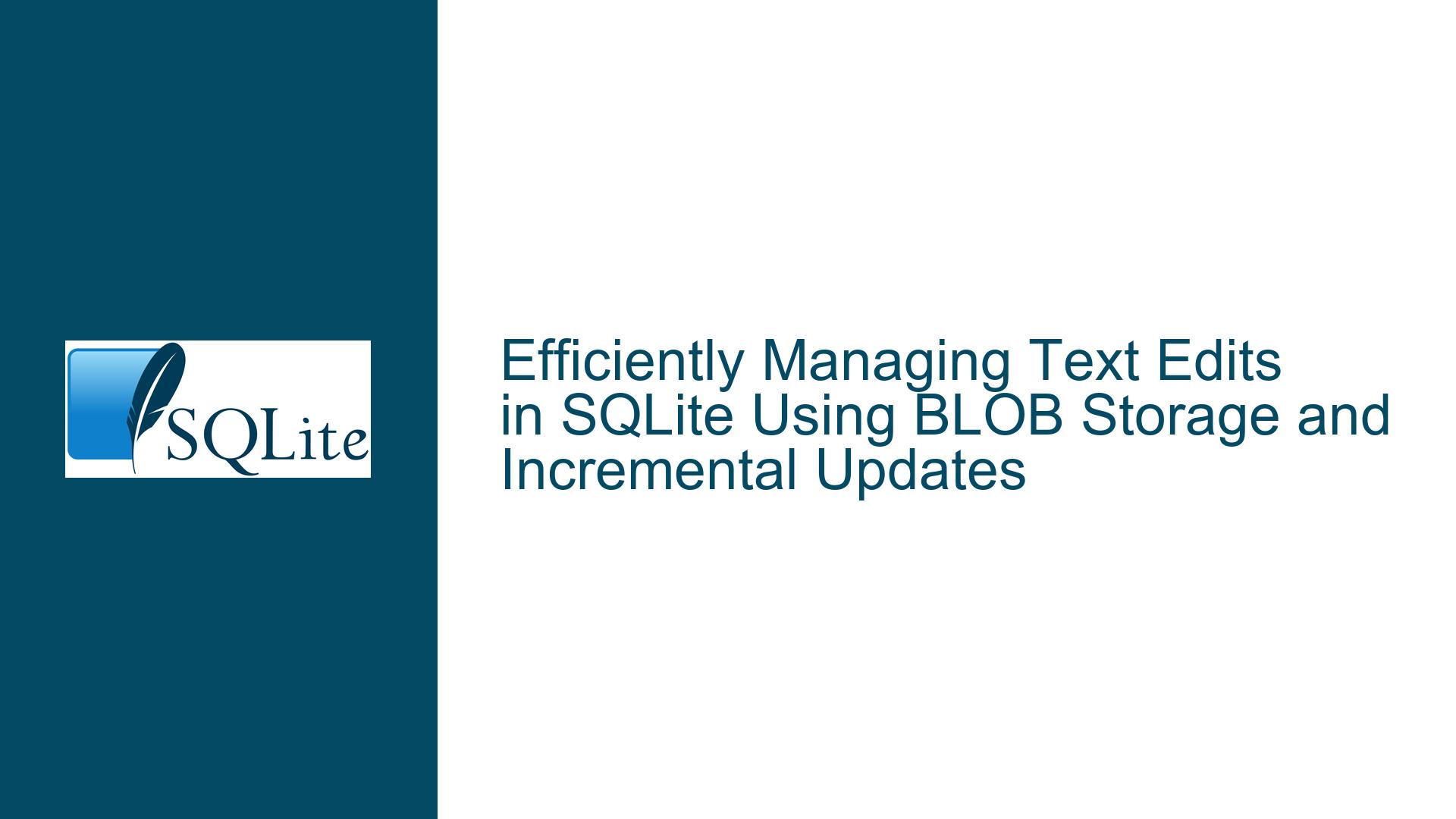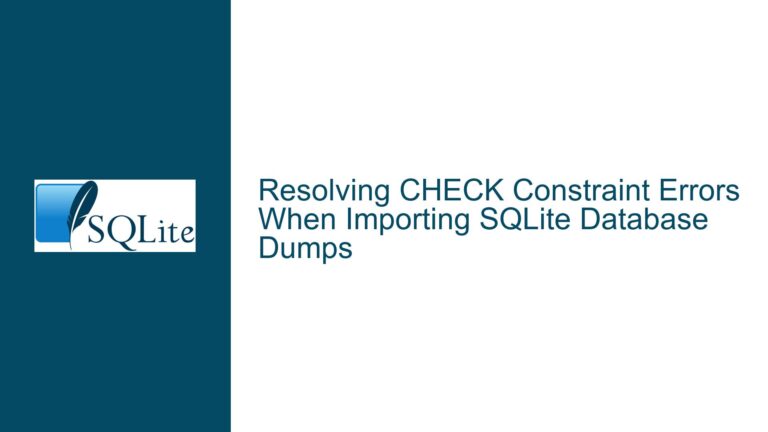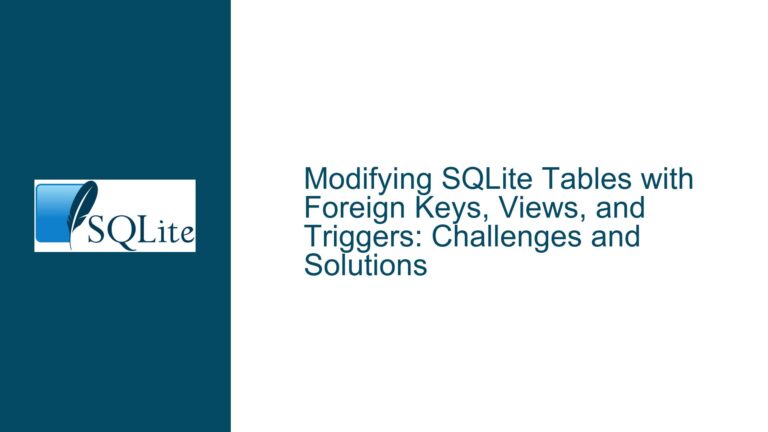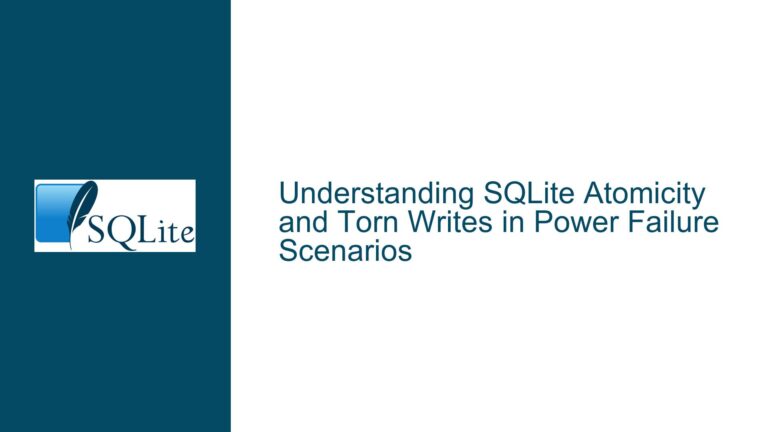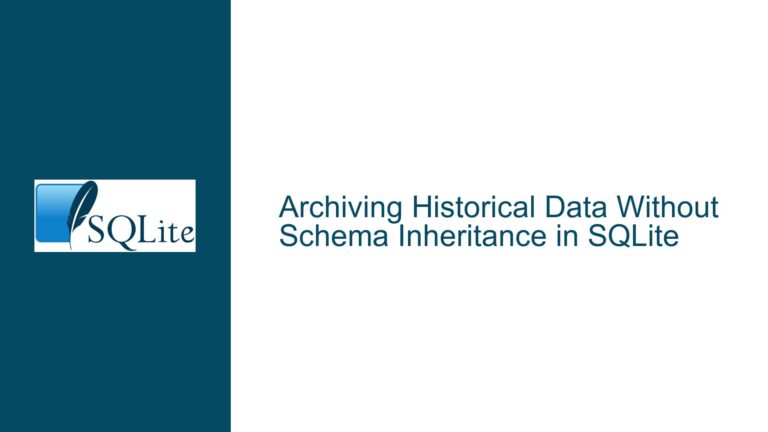Efficiently Managing Text Edits in SQLite Using BLOB Storage and Incremental Updates
Optimizing Text Document Storage and Updates in SQLite Databases
Core Challenge: Balancing Performance and Data Integrity for Text Editor State Management
The central problem revolves around efficiently storing and updating text documents in an SQLite database while supporting undo/redo functionality. Traditional approaches involve overwriting the entire document (stored as a BLOB or text field) on every edit, which becomes inefficient for larger documents (1–2 MB). Incremental BLOB I/O and data structures like piece tables have been proposed as alternatives, but their implementation introduces complexities such as handling variable-length edits, preserving undo/redo history across sessions, and minimizing database write operations.
Key considerations include:
- Document Size Sensitivity: Small notes (KB-range) may tolerate full overwrites, but multi-page documents (MB-range) demand optimized storage.
- Undo/Redo Chain Persistence: The system must retain granular edit history to reconstruct prior states, even after application restarts.
- SQLite-Specific Constraints: Incremental BLOB I/O in SQLite cannot resize BLOBs, limiting its utility for text edits that add/remove characters.
- Data Structure Complexity: Piece tables and similar structures require careful schema design to map logical document states to database rows.
Root Causes of Inefficiency in Text Document Storage
Full Document Overwrites on Minor Edits
Writing the entire document to the database for every keystroke or edit consumes excessive I/O bandwidth and increases transaction latency. This is particularly problematic for collaborative editors or applications with frequent autosave features.Inadequate Handling of Variable-Length Edits
SQLite’s incremental BLOB I/O API (sqlite3_blob_open(),sqlite3_blob_write()) allows byte-level modifications to BLOBs but cannot expand or shrink their size. Text edits often involve insertions/deletions that alter the document length, rendering this API unsuitable for direct use.Undo/Redo History Fragmentation
Storing undo/redo steps as separate database entries without a cohesive strategy leads to fragmented data. For example, if deletions are not tracked alongside insertions, reconstructing prior states becomes impossible.Misalignment Between In-Memory and On-Disk Representations
Piece tables and append buffers work efficiently in memory but require translation to persistent storage. Directly serializing these structures to BLOBs may not account for transactional consistency or efficient partial updates.
Structured Solutions for Scalable Text Editing in SQLite
1. Hybrid Storage: Combining Full Snapshots with Delta Encoding
Approach:
- Store periodic full snapshots of the document (e.g., every 100 edits) as BLOBs.
- Record individual edits (deltas) in a separate table, capturing insertions, deletions, and their positions.
Schema Example:
CREATE TABLE document_snapshots (
snapshot_id INTEGER PRIMARY KEY,
content BLOB,
created_at TIMESTAMP DEFAULT CURRENT_TIMESTAMP
);
CREATE TABLE document_edits (
edit_id INTEGER PRIMARY KEY,
snapshot_id INTEGER REFERENCES document_snapshots(snapshot_id),
edit_type TEXT CHECK(edit_type IN ('insert', 'delete')),
position INTEGER,
text TEXT, -- Holds inserted text or deleted text
created_at TIMESTAMP DEFAULT CURRENT_TIMESTAMP
);
Workflow:
- On application startup, load the latest snapshot and replay subsequent edits from the
document_editstable. - When the edit count since the last snapshot exceeds a threshold (e.g., 100), create a new snapshot and prune old edits.
Advantages:
- Reduces write amplification by avoiding full document writes for every edit.
- Preserves undo/redo history indefinitely.
Trade-offs:
- Requires additional logic to manage snapshot intervals and edit replay.
- Introduces read overhead when reconstructing the current document state.
2. SQLite-Aware Piece Table Implementation
Adapting Piece Tables for SQLite:
A piece table represents a document as a series of segments ("pieces") referencing an original buffer and an append buffer. Each insertion modifies the append buffer, while deletions split existing pieces.
Schema Design:
CREATE TABLE document_pieces (
piece_id INTEGER PRIMARY KEY,
document_id INTEGER REFERENCES documents(id),
source TEXT CHECK(source IN ('original', 'append')),
start_offset INTEGER,
length INTEGER,
deleted BOOLEAN DEFAULT 0
);
CREATE TABLE append_buffer (
buffer_id INTEGER PRIMARY KEY,
document_id INTEGER REFERENCES documents(id),
content BLOB
);
Operational Steps:
Initial Document Save:
- Insert a single piece referencing the
originalsource withstart_offset=0andlength=N. - Store the full content in a
documentstable BLOB column.
- Insert a single piece referencing the
Handling Insertions:
- Append new text to the
append_bufferfor the document. - Create a new piece referencing the
appendsource,start_offset(end of previous append buffer), andlength(new text length).
- Append new text to the
Handling Deletions:
- Split existing pieces at deletion boundaries.
- Mark affected pieces as
deleted=1or adjust theirlength.
Undo/Redo Integration:
- Log each edit operation in an
edit_historytable with inverse operations for undo. - Example: An insertion logs an
edit_type='insert'withpositionandtext, while its undo entry logsedit_type='delete'at the same position with the same text.
Performance Considerations:
- Indexing: Add indexes on
document_pieces(document_id, deleted)to speed up reconstruction. - Buffer Management: Limit append buffer size by periodically merging it into the original document (e.g., during saves).
3. Leveraging SQLite’s Full-Text Search (FTS) for Append-Only Logging
Use Case:
For applications prioritizing undo/redo integrity over storage efficiency, an append-only edit log can be combined with SQLite’s FTS extension for efficient text reconstruction.
Schema:
CREATE TABLE edit_log (
edit_id INTEGER PRIMARY KEY,
document_id INTEGER REFERENCES documents(id),
operation TEXT CHECK(operation IN ('insert', 'delete')),
position INTEGER,
text TEXT,
reversed BOOLEAN DEFAULT 0 -- Marks undone/redone operations
);
CREATE VIRTUAL TABLE document_fts USING fts5(content);
Document Reconstruction:
- Use
document_ftsto maintain the current text state. - On each edit, update
document_ftsand log the operation inedit_log.
Undo/Redo Implementation:
- Undo: Apply the inverse operation (e.g., delete inserted text) and mark
reversed=1. - Redo: Re-apply the original operation and mark
reversed=0.
Pros and Cons:
- Advantages: Simplifies undo/redo logic and leverages SQLite’s optimized text search.
- Disadvantages: FTS tables consume additional storage and may not handle very large documents efficiently.
4. Partial Updates with JSON1 Extension
Scenario:
For documents structured as JSON (e.g., rich text with metadata), SQLite’s JSON1 extension enables partial updates via json_set(), json_insert(), and json_remove().
Example:
UPDATE documents
SET content = json_set(content, '$.text', json_extract(content, '$.text') || ?)
WHERE id = ?;
Limitations:
- Requires document content to adhere to a JSON schema.
- Not suitable for plain text or non-structured data.
Critical Evaluation of Incremental BLOB I/O
While incremental BLOB I/O seems promising for editing text stored as BLOBs, its inability to handle resizing operations makes it impractical for most text editing scenarios. However, it can be used in niche cases where edits only modify existing bytes (e.g., fixed-width formatted text).
Workaround for Fixed-Length Edits:
- Pre-allocate BLOBs with padding bytes.
- Use
sqlite3_blob_write()to overwrite specific regions.
Example:
// C API example: Overwrite 10 bytes starting at offset 50
sqlite3_blob_open(db, "main", "documents", "content", document_id, 0, &blob);
sqlite3_blob_write(blob, new_text, 10, 50);
Caution:
- Padding strategies increase storage overhead.
- Requires careful bounds checking to prevent data corruption.
Conclusion: Pragmatic Trade-Offs for SQLite-Based Text Editors
- Small Documents (≤100 KB): Full overwrites are acceptable due to SQLite’s efficient single-row updates.
- Medium Documents (100 KB – 2 MB): Use hybrid snapshot-delta or piece table approaches to balance write volume and undo/redo complexity.
- Large Documents (>2 MB): Consider external file storage with SQLite metadata (e.g., storing file paths and edit logs).
Final Recommendations:
- Benchmark Real-World Usage: Profile insert/update/delete latency with representative document sizes.
- Leverage SQLite’s Strengths: Use transactions to batch edits and indexes to speed up history replay.
- Avoid Premature Optimization: Start with full overwrites and optimize only if performance becomes an issue.
By aligning storage strategies with SQLite’s capabilities and the specific requirements of the text editor, developers can achieve responsive performance without compromising data integrity.
